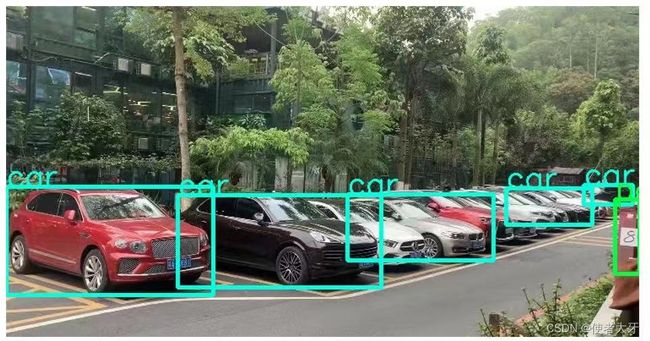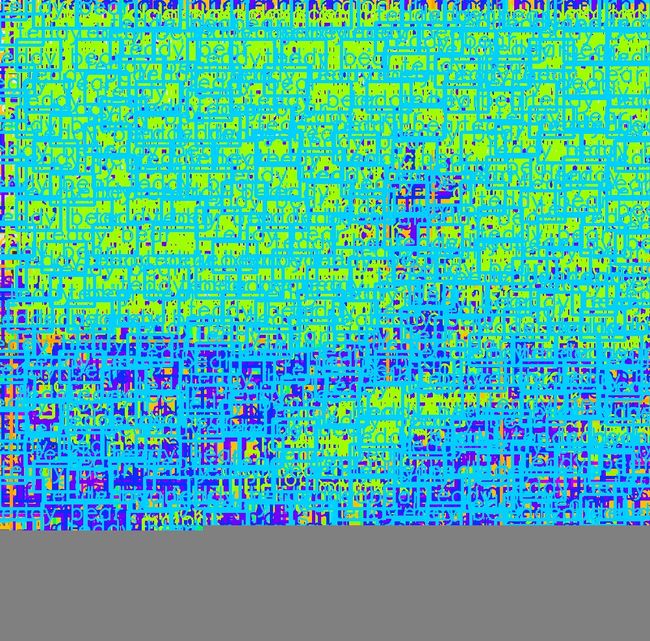基于Pytorch的YoLoV4模型代码及作品欣赏
文章目录
-
-
-
- 一、前言
- 二、YoLoV4的作品欣赏
- 三、YoLo模型的源代码
-
- Backbone:
- Neck:
- Head:
- 四、写在最后
-
-
一、前言
在正式文章开始前,先写几句废话把。。。
距前面写完YoLoV4架构已经两个月过去,在这两个月中断断续续写代码,再debug。终于完成了YoLoV4的模型构建及运行,还得到了一些挺有意思的结果。
先说下学习感受:
第一,YoLo其实并不难:它有点像大学时候学的工程制图,其中,每个子构件,每条线,每个注释都比较简单易懂,但是合成一个整体,却是一个非常复杂的有机体。
第二,Debug要比Coding消耗更多的时间:所有的代码,基本上半个月就写完了。但是Debug用了一个半月。Debug过程确实对于YoLo还有Python的学习都是很有好处的,理解更深入一个层次。
二、YoLoV4的作品欣赏
我把源码部分放在最后,因为它实在是有点长。而且本着学以致用的精神,不妨可以先看下YoLo可以实现什么功能。
①第一张图:实拍路景

可以看到YoLo很好地识别到了Truck和Person,但是对于最左边的Truck,可能因为不完整,没有识别出来。
②第二章图:实拍路景

比较简单的一个构图,识别起来毫无压力。
③第三张图:实拍路景

对于这种车辆比较密集的情况,不能每台车都框出来,但是总的区域还是比较准确的。
接下来,再搞点不一样的
④二次元图像

动漫bleach中的乌尔奇奥拉,被识别成了盆栽。(不过确实有点像)
⑤游戏壁纸

影魔被识别成Cake(难道学习样本中有影魔形状的Cake?)
⑥抖音艺术图(侵删)

这是有点意外的,居然还能识别成person。
⑦抖音艺术图(侵删)

这张图我觉得很好地诠释了YoLo的强大,因为它输出的结果,比我人脑乍一看识别出的内容更加丰富!而且框选的也很准确!
三、YoLo模型的源代码
按照YoLo的架构,我将把YoLo模型的代码分为Backbone,Neck,Head三个部分。
关于代码的理解写在源码注释中。
在放上代码之前,先声明一点:这里的源代码,只包含YoLo的模型部分,要想完整地运行出上面的结果,还需要:
①读取图像,画出Bounding box,生成新图像的python代码辅助部分;
②训练神经源网络,得到预训练后的权值,并导入到模型中。
(这两部分我是在别人的帮助下完成的,在这里就不附上了)
这里在多说一句,关于②导入预训练的权值,如果试下不导入,输出的结果就是下面这种混乱的状态。
这也很好理解,因为神经元模型并没有学习过很多样本,它也不知道什么样的结果应该输出Person,什么样的结果应该输出Cake。可见预训练对于神经元模型的重要性。
Backbone:
import torch
import torch.nn.functional as F
import torch.nn as nn
import math
import numpy as np
class Mish(nn.Module): #定义激活函数Mish
def __init__(self):
super(Mish,self).__init__()
def forward(self,x):
return x*torch.tanh(F.softplus(x))
class CBM(nn.Module): #定义CBM模块
def __init__(self,in_channels, out_channels, kernel_size, stride=1):
super(CBM,self).__init__()
self.conv = nn.Conv2d(in_channels, out_channels, kernel_size, stride, kernel_size//2, bias=False) #定义卷积层
self.bn = nn.BatchNorm2d(out_channels)
self.activation = Mish()
def forward(self,x):
x = self.conv(x)
x = self.bn(x)
x = self.activation(x)
return x
class Res_Unit(nn.Module): #构建Res Unit,回忆下Res Unit的结构=CBM*2+残差相加
def __init__(self,channels,hidden_channels = None):
super(Res_Unit,self).__init__()
if hidden_channels == None:
hidden_channels = channels
self.block = nn.Sequential(
CBM(channels, hidden_channels, 1) , #第一个CBM的卷积核为1×1,作用是降维提高运算效率
CBM(hidden_channels,channels, 3)
)
def forward(self,x):
return x+self.block(x) #计算残差
class CSPNet(nn.Module):
# -----------CSPNet原理图-----------------------------------------------------------------------------------
#
# CSPX ==> [downsample]--> [CBM(split_conv0)]--------------------->[concat]->[downsample]
# | ↑
# |-> [CBM(split_conv1)]-->[Res Unit(block_conv)]--|
#
# -----------CSPNet原理图------------------------------------------------------------------------------------
def __init__(self,in_channels, out_channels, num_Res_Unit, first): #num_Res_Unit表示在CSPNet中,Res_Unit的个数
super(CSPNet,self).__init__()
self.downsample_conv = CBM(in_channels, out_channels, 3, stride=2) #在CSP模块最开始,有一个下采样
if first == True: #第一个CSP和后面的CSP不同,后面的CSP输出会降维,所以需要区分是否是first CSP
self.split_conv0 = CBM(out_channels, out_channels, 1) #对应结构图中CPSX模块中,上面的那个CBM。输入为下采样之后的输出。
self.split_conv1 = CBM(out_channels, out_channels, 1) #对应结构图中CPSX模块中,下面第一个的那个CBM
self.block_conv = nn.Sequential(
Res_Unit(channels=out_channels, hidden_channels=out_channels//2),
CBM(out_channels,out_channels,1) #第一个CSPNet是CSP1,所以这里Res_Unit刚好只有一个
) #对应结构图中CPSX模块中,下面的那个Res_Unit 及后面的CBM
self.concat_downsample = CBM(out_channels*2, out_channels,1) #这是concat之后的下采样模块,因为concat,输入变成out_channels的2倍
else:
self.split_conv0 = CBM(out_channels, out_channels//2, 1) # 对于非第一个CSP模块,输出会降维,所以增加//2
self.split_conv1 = CBM(out_channels, out_channels//2, 1)
self.block_conv = nn.Sequential(
*[Res_Unit(channels=out_channels//2) for _ in range(num_Res_Unit)]
,CBM(out_channels//2, out_channels//2, 1)
) # 用*[]构建num_Res_Unit个输入参数()
self.concat_downsample = CBM(out_channels, out_channels,1) # 这是concat之后的下采样模块
def forward(self,x): #x为要处理的tensor
x = self.downsample_conv(x)
x0 = self.split_conv0(x)
x1 = self.split_conv1(x)
x1 = self.block_conv(x1)
x = torch.cat([x1,x0],dim = 1)
x = self.concat_downsample(x)
return x
#======================backbone结构构建=============================================
class Yolo_backbone(nn.Module):
def __init__(self):
super(Yolo_backbone, self).__init__()
#---------构建Darknet 53的结构------------------------------------
self.conv1 = CBM(3, 32, kernel_size=3, stride=1) #对应第一个CBM,输入原始图像通道为3,输出通道为32
self.structure = nn.ModuleList([
CSPNet(32, 64, num_Res_Unit = 1, first= True),
CSPNet(64, 128, num_Res_Unit = 2, first=False),
CSPNet(128, 256, num_Res_Unit = 8, first=False),
CSPNet(256, 512, num_Res_Unit = 8, first=False),
CSPNet(512, 1024, num_Res_Unit = 4, first=False),
]) #每经过一个CSP,输出通道数翻倍
#-----------------------------------------------------------------
#-------------下面进行网络初始化---------------------------------
for m in self.modules():
if isinstance(m,nn.Conv2d) : #卷积核初始化,还有其他的卷积核初始化方法
n = m.kernel_size[0]* m.kernel_size[1]* m.out_channels
m.weight.data.normal_(0,math.sqrt(2./n))
if isinstance(m,nn.BatchNorm2d): #BN层初始化
m.weight.data.fill_(1)
m.bias.data.zero_()
def forward(self, x):
x = self.conv1(x)
x = self.structure[0](x)
x = self.structure[1](x)
out1 = self.structure[2](x) #参考YOLO的整体框架结构,从此开始有3个输出,输出顺序out1,out2,out3
out2 = self.structure[3](out1)
out3 = self.structure[4](out2)
return out1,out2,out3
#==============以上,backbone构建完成 =============================
def load_model_path(model,pth): #model是网络模型,pth是预训练权重的文件路径
device = torch.device('cuda' if torch.cuda.is_available() else 'cpu')
model_dict = model.state_dict() #所有权重weight的label和parameter将输入到字典model_dict中。
# 在pytorch中,torch.nn.Module模块中的state_dict变量存放训练过程中需要学习的权重和偏置系数
# model_dict是还未训练的权值文件
pretrain_dict = torch.load(pth,map_location=device) #导入已经训练好的权值文件
matched_dict = {}
for k,v in model_dict.items():
if k.find('backbone') == -1:
key = 'backbone.'+k.replace('structure','stages').replace('block_conv','blocks_conv').replace('concat_downsample','concat_conv')
#上面这里是发现已经训练好的权值,和要替换的未训练的权值名称有些差异,所以要替换下这些名称
if np.shape(pretrain_dict[key]) == np.shape(v):
matched_dict[k] = v
#上面这个for的作用:这里可以先打印下pretrain_dict中的变量名,可以看到几乎都是backbone开头,这些都是训练好的backbone的权值
#model_dict是未训练的模型的权值文件,通过变量key找到在pretrain_dict中的对应变量,把训练好的变量赋值给matched_dict
model_dict.update(matched_dict) #更新我们自己YOLO的权值文件(也就是model_dict)
model.load_state_dict(model_dict)
return model
def YOLO_backbone_pretrain(pretrain): #进行网络预训练
model = Yolo_backbone()
load_model_path(model, pretrain)
return model
if __name__ == "__main__":
backbone = YOLO_backbone_pretrain('pth/yolo4_weights_my.pth') #这个路径放入预训练好的权值文件
Neck:
这部分我认为是YoLo中最复杂、最容易出错、需要耐心的一部分,必须要严格参照YoLo的构架图。
import torch
import torch.nn as nn
from collections import OrderedDict
from YOLO_backbone import *
def CBL(channel_in,channel_out,kernel_size,stride=1): #编辑NECK中的CBL模块
if kernel_size:
pad = (kernel_size-1)//2
else:
pad = 0
return nn.Sequential(OrderedDict([
('conv',nn.Conv2d(channel_in,channel_out,kernel_size=kernel_size,stride=stride,padding=pad)),
('bn',nn.BatchNorm2d(channel_out)),
('leaky_relu',nn.LeakyReLU(0.1))
]))
class SPP(nn.Module): #定义SPP模块
def __init__(self,pool_sizes=[13,9,5]): #13,9,5怎是工程经验值
super(SPP, self).__init__()
self.maxpools = nn.ModuleList([nn.MaxPool2d(pool_size, 1, pool_size//2) for pool_size in pool_sizes])
def forward(self,x):
features = [maxpool(x) for maxpool in self.maxpools]
features = torch.cat(features+[x],dim=1) #注意:虽然经过maxpooling之后features的维度会比x小很多,但是因为concat的broadcast机制,仍然可以拼接得上
return features
class upsample(nn.Module): #定义卷积+上采样模块
def __init__(self, in_channels, out_channels):
super(upsample,self).__init__()
self.up_sample = nn.Sequential(
CBL(in_channels,out_channels,1),
nn.Upsample(scale_factor=2,mode='nearest')
)
def forward(self,x):
return self.up_sample(x)
def CBL_3(channel_list,channel_in): #定义CBL*3模块(通道数调用的时候需要输入)
m = nn.Sequential(
CBL(channel_in, channel_list[0],1),
CBL(channel_list[0],channel_list[1],3),
CBL(channel_list[1],channel_list[0],1)
)
return m
def CBL_5(channel_list,channel_in): #定义CBL*5模块
m= nn.Sequential(
CBL(channel_in, channel_list[0],1), #降维,1*1卷积核降维?
CBL(channel_list[0],channel_list[1],3), #升维,3*3卷积核升维?
CBL(channel_list[1],channel_list[0],1),#降维
CBL(channel_list[0], channel_list[1], 3),#升维
CBL(channel_list[1], channel_list[0], 1)#降维
)
return m
def YOLO_before_head(channel_list,channel_in): #定义head前面的CBL+conv模块
m = nn.Sequential(
CBL(channel_in, channel_list[0],3),
nn.Conv2d(channel_list[0],channel_list[1],1)
)
return m
#-------------------下面通过上面构造的各个子组件,构建整个neck的网络-------------------------------
class YOLO_neck_body(nn.Module):
def __init__(self, num_anchors, num_classes):
super(YOLO_neck_body, self).__init__()
# self.backbone = YOLO_backbone_pretrain('pth/yolo4_weights_my.pth') #!!!这里也会显示预训练数据名冲突,所以线注释掉!!!用下面的替换
self.backbone = Yolo_backbone()
# 以下内容需要参考Neck的架构图
# 首先编写①
self.CBL31_1 = CBL_3([512,1024],1024) #通道数按照YOLO的规定
self.SPP_1 = SPP()
self.CBL32_1 = CBL_3([512,1024],2048)
#继续写②
self.upsample_2 = upsample(512,256) #通道数同样是按YOLO的架构规定,不用纠结。注意:upsample内部已经包含前面的CBL了
self.CBL_2 = CBL(512,256,1)
self.CBL5_2 = CBL_5([256,512],512)
#继续写③
self.upsample_3 = upsample(256,128)
self.CBL_3 = CBL(256,128,1) #这里第一个256原来是512
self.CBL5_3 = CBL_5([128,256],256)
#写第一个head输出(76*76这个)
final_out_channels = num_anchors*(5+num_classes) #等于255
self.yolo_head76 = YOLO_before_head([256,final_out_channels],128)
#继续写④
self.downsample_4 = CBL(128,256,3,stride=2) #在④的CBL之前有个downsample,所以stride=2
self.CBL5_4 = CBL_5([256,512],256)
self.downsample2_4 = CBL(256,256,3,stride=2) #R5从④出来后有一个downsample
self.yolo_head38 = YOLO_before_head([512,final_out_channels],256) #这是第2个head,38*38
#继续写⑤
self.downsample_5 = CBL(256,512,3,stride=2)#同样,在⑤的CBL之前有个downsample,所以stride=2
self.CBL5_5 = CBL_5([512,1024],512)
self.CBL_5 = CBL(1024,512,3,stride=1)
self.yolo_head19 = YOLO_before_head([1024,final_out_channels],512) #这是第3个head,19*19
def forward(self,x):
#forward要严格按照YOLO的架构顺序,是个比较精细的工作
x2,x1,x0 = self.backbone(x) #x2,x1,x0对应backbone的三个输出,注意:对应backbone的结构,输出顺序为x2->x1->x0
# 先写R1,R1为最上面的路径
R1 = self.CBL31_1(x0)
R1 = self.SPP_1(R1)
R1_before_upsample = self.CBL32_1(R1) #引出一条之路,给后面的R6用
R1 = self.upsample_2(R1_before_upsample)
print('开始neck部分debug')
print('R1_before_upsample:',R1_before_upsample.shape)
print('R1:',R1.shape)
#写R2,上面第二条路径
R2 = self.CBL_2(x1) #引入x1,仍然是按照yolo的架构
print('R2:',R2.shape)
R1_and_2 = torch.cat([R1,R2],axis=1)
print('R1_and_2:',R1_and_2.shape)
R1_and_2 = self.CBL5_2(R1_and_2)
print('R1_and_2:',R1_and_2.shape)
R1_and_2 = self.upsample_3(R1_and_2) #upsample包括前面的CBL
print('R1_and_2:',R1_and_2.shape)
#写第三条路径,R3
R3 = self.CBL_3(x2) #引入x2
R1_and_2_and_3 = torch.cat([R3,R1_and_2],axis=1)
R1_and_2_and_3 = self.CBL5_3(R1_and_2_and_3)
print('R3:',R3.shape)
print('R1_and_2_and_3:',R1_and_2_and_3.shape)
#写第四条路径,R4
R4 = R1_and_2_and_3
print('R4:',R4.shape)
#写第五条路径,R5
R5 = torch.cat([R4,R1_and_2],axis=1)
R5 = self.CBL5_4(R5)
R5_beforehead = self.downsample2_4(R5) #创造一个断点给输出
print('R5_beforehead:',R5_beforehead.shape)
#写第六条路径,R6
R5 = self.downsample_5(R5_beforehead)
print('R5:',R5.shape)
print('R1_before_upsample:',R1_before_upsample.shape)
R6 = torch.cat([R5,R1_before_upsample],axis=1)
R6 = self.CBL_5(R6)
print('R6:',R6.shape)
#写输出
print('进入头部前再检查一遍neck的输入张量')
print('76*76:',R1_and_2_and_3.shape)
print('38*38:',R5_beforehead.shape)
print('19*19:',R6.shape)
out76 = self.yolo_head76(R1_and_2_and_3)
out38 = self.yolo_head38(R5_beforehead)
out19 = self.yolo_head19(R6)
return out76,out38,out19
if __name__ == '__main__':
model = YOLO_neck_body(3,80)
# load_model_path(model,'pth/yolo4_weights_my.pth')
Head:
import torch.nn as nn
import torch.nn.functional as F
import torch
def yolo_decode(output,num_class, anchors, num_anchors, scale):
#anchors释意见Yololayer;
#output=[B,A*n_ch,H,W],这个是head输出的张量,这个张量中的数据顺序、结构是由neck的模型结构决定的
device = None
if output.is_cuda:
device = output.get_device()
n_ch = 4+1+num_class #tx,ty,th,tw,obj
A = num_anchors #num_anchors = 3
B = output.size(0) #output第一个B是batch,代表每次处理图片的批次数
H = output.size(2) #output第三个是H,纵向网格数 = 19或38或76
W = output.size(3) #output第四个是W,横向网格数 = 19或38或76
output = output.view(B,A,n_ch,H,W).permute(0,1,3,4,2).contiguous() #重组output中数据的顺序,变成[B,A,H,W,n_ch],为了下一步方便取bx,by,bw,bh
tx = output[...,0] #n_ch=85=[tx,ty,tw,th,obj,coco]
ty = output[...,1]
tw = output[...,2]
th = output[...,3]
obj = output[...,4]
cls = output[...,5:]
print('tw:',tw.shape)
print('th:',th.shape)
#bx,by,bw,bh是bounding box中心点位置及框的长宽的值;tx,ty,tw,th是网络学习得到的值(其实是list),需要用tx,ty,tw,th解码得出bx,by,bw,bh。
#注意!!!这里的bx,by,bw,bh的单位是网格数(也就是按19*19,38*38,76*76分割的网格数),而不是实际的像素数
obj = torch.sigmoid(obj)
cls = torch.sigmoid(cls)
grid_x = torch.arange(W,dtype=torch.float).repeat(1,3,W,1).to(device)
# grid_y = torch.arange(H, dtype=torch.float).repeat(1, 3, 1, H).to(device)
grid_y = torch.arange(H, dtype=torch.float).repeat(1, 3, H, 1).permute(0, 1, 3, 2).to(device)
print('开始头部debug')
print('tx:',tx.shape)
print('ty:',ty.shape)
print('grid_x:',grid_x.shape)
print('grid_y:',grid_y.shape)
bx = grid_x + torch.sigmoid(tx)
by = grid_y + torch.sigmoid(ty)
for i in range(num_anchors):
tw[:,i,:,:] = (torch.exp(tw[:,i,:,:])*scale -0.5*(scale-1))*anchors[i*2] #计算bw,因为Anchor在第二维(output中的A),i也对应要在第二维;因为anchor要跳一位去宽度值,所以要*2
tw[:,i,:,:] = (torch.exp(th[:,i,:,:])*scale - 0.5*(scale-1))*anchors[i*2+1] #与上面同理
bx = (bx / W).unsqueeze(-1) #进行归一化,为了方便模型训练
by = (by / H).unsqueeze(-1) #同上
bw = (tw / W).unsqueeze(-1) #同上
bh = (th / H).unsqueeze(-1) #同上
print('bx:',bx.shape)
print('by:',by.shape)
print('bw:',bw.shape)
print('bh:',bh.shape)
box = torch.cat((bx,by,bw,bh),dim=-1).reshape(B,A*H*W,4)
obj = obj.unsqueeze(-1).reshape(B,A*H*W,1) #索引的时候,损失了最后一个维度,要补回来
cls = cls.reshape(B,A*H*W,num_class)
head_output = torch.cat([box, obj, cls],dim = -1)
return head_output
class YoloLayer(nn.Module):
def __init__(self,img_size, anchor_mask=[],num_class =80, anchors = [],num_anchors=9, stride =32, scale = 1):
super(YoloLayer,self).__init__()
self.anchor_mask = anchor_mask #anchor_mask,[[6,7,8],[3,4,5],[0,1,2]],是一个二维数组
self.num_class = num_class #coco类别有80类
self.anchors = anchors #每个head有3个anchor,共9个anchor,anchors = [12, 16, 19, 36, 40, 28, 36, 75, 76, 55, 72, 146, 142, 110, 192,243, 459, 401]
# 共9组数据12,16 19,36 40,28; 36,75 76,55 72,146; 142,110 192,243 459,401
self.num_anchors = num_anchors #每个head有3个anchor,共9个anchor,num_anchors=9
self.anchor_step = len(anchors) // num_anchors #anchor_step = 18/9 = 2
self.stride = stride #stride是网格的像素数,stride*网格数=608
self.scale = scale #scale 一般取1
self.feature_length = [img_size[0]//8,img_size[0]//16,img_size[0]//32]
self.img_size = img_size
def forward(self,output):
if self.training: #????
return output
masked_anchors = []
for m in [0,1,2,3,4,5,6,7,8]:
masked_anchors += self.anchors[m*self.anchor_step:(m+1)*self.anchor_step] #取所有mask对应的所有的anchor
masked_anchors = [anchor/self.stride for anchor in masked_anchors] #这个操作我理解是进行单位转换,把像素数除以每个网格的像素数,得到网格数,传入上面yolo_decode
data = yolo_decode(output, self.num_class, masked_anchors, len(self.anchor_mask),scale = self.scale)
return data
四、写在最后
对于上面的图像输出结果,其实最开始我是很诧异的,因为YoLo神经元网络模型,其实数学本质上就是非线性运算(Leaky Relu),并不复杂。没想到经过一系列的组合、堆叠,居然能实现这么复杂的功能!
然而,刚好在最近看到的一本书里看到了一个理论说明了这个现象,送给大家:
如果让计算机反复地计算极其简单的运算法则,那么就可以使之发展成为异常复杂的模型,并可以解释自然界中的所有现象,支配宇宙的原理无非就是区区几行程序代码。
-Stephen Wolfram
